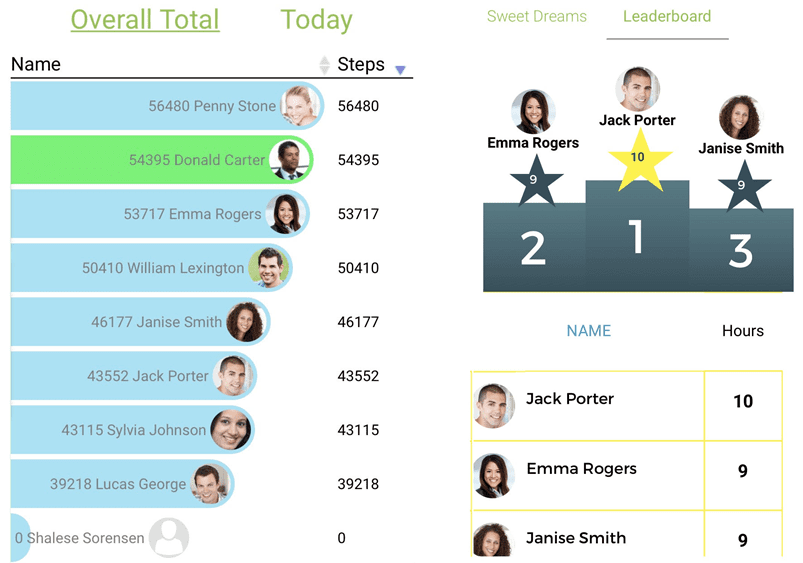More employees than ever are now working remotely, but there is nothing new about working outside of on office or without other employees. Truckers, long-haulers, traveling nurses, river barge captains, and even many airline employees have always been remote workers. Traveling sales people, cab drivers, and even package delivery workers work away from an office without other employees.

Not all remote workers sit in front of computers, but many do. Regardless of the type of work they do, they all work in somewhat isolated locations with few, if any, colleagues working with them. They are often far removed from any corporate or centralized office.
Today, remote working has become a productive and acceptable way for individuals to have gainful employment without the need to work from one centralized location. However, offering a wellness program to remote workers has specific challenges and obstacles not experience by wellness programs only offered in a centralized locations with onsite employees.
This article will help you solve the biggest problem with offering wellness programs with remote workers: lack of physical, face-to-face contact with other employees.

How do You Keep Your Employees Healthy While They’re Working from Home?
In order for wellness programs to successfully impact the lives of remote workers they must overcome several administrative challenges:
- It can be difficult to get access to every aspect of the wellness program. For example, a biometric screening is much harder to do when employees are spread out.
- Without social interaction with others, group support for healthy living is hard to get. It’s easier to adopt healthy behaviors with others help and encouragement.
- Team challenges are impossible unless you can put together a team.
- Onsite participation in wellness activities is impossible or very limited for remote workers.
- Good luck getting remote workers to attend a group lunch and learn or onsite fitness class.
- The effects of long-term isolation can cause some employees to struggle with mental and emotional health challenges like depression and loneliness.
RELATED: 5 Wellness Program Ideas for Blue Collar Workers
6 Strategies for Successful Wellness with Remote Workers
To overcome these challenges, I’ve compiles a list of 6 time-tested strategies to help any wellness program more effectively reach and impact remote workers. WellSteps uses each of these strategies with clients that have remote workers.
1) Involve Others in the Wellness Efforts of Remote Workers
Wellness programs help employees adopt and maintain healthy behaviors. Behavior change is more lasting when we have the encouragement, support, and company of others.
Some remote employees live with significant others while others have close relationships with friends and family members. Regardless of the source of your support, the most important part is that you have social support from someone who can hold you accountable and who encourages you.
Regular exercise, healthy eating, controlling stress and other healthy behaviors are easy to maintain when others share these same behaviors. In some homes, the tasks of shopping for and the cooking of healthy foods is sometimes carried by just one person.

It’s hard to eat healthy if the food “gate keepers” don’t have a healthy diet. Hence, having support from others is vital to having a healthy diet.
WellSteps has always supported the need to have help from others. In all of our wellness solutions, spouses or significant others can always participate for free.
In fact, we feel that this concept is so important that all wellness program participants can invite anyone to participate with them, even if they are just a friend or neighbor.
Wellness programs for remote employees will be more effective if remote workers can invite others to join them in this journey to better health.
2) Use Team-based Wellness Activities and Challenges with Remote Employees
Your remote employees are already having meetings with other employees. Remote employees can be active, participating members of strategic teams.
Instead of using teams to complete work projects, wellness programs for remote employees can use teams to let employees compete and be active with others.
For example, the WellSteps Move It Coast to Coast campaign allows employees to create teams that compete with each other as each team races from the West Coast to the East Coast of the United States. Each individual can contribute exercise steps or minutes to his or her team effort.

Team members can chat or text each other, there are leader boards where individual members can see how they are doing in comparison to others, and there are team comparisons as each team battles to make it all the way across the map.
The great thing about team-based wellness activities is that they can include both remote and on-site employees. In fact, anyone can participate with a web enabled device. It’s fun, for example, to have a team of remote workers compete with a team of on-site workers.
Some team-based wellness activities allow teams to compete with each other or allow for a single team to pitch in and work together to accomplish some difficult.
Either way, teams allow remote workers to interact and communicate with other employees. They may not be physically face-to-face, but they are able to chat, talk smack, share pictures and encourage each other.
3) Make Wellness Activities Virtual
With the use of technology, employee wellness programs for remote workers can do almost anything a live on-site wellness program could do.
This technology includes online communications such as SMS, texting, or chat functions. It includes online video conferencing and data transfer capabilities where activity data from fitness devices or mobile phones can be uploaded and automatically synced with their wellness account.

Wellness programs for remote workers should leverage technology at every possible opportunity. For example, instead of having a wellness lunch and learn on location, a qualified wellness speaker could speak remotely and participants could watch and participate virtually.
The same health information could be shared and points could be given for attendance, just like an actual presentation.
Instead of having a live meeting with a health coach, these meetings could be done virtually.
Traditionally, gathering biometric data from employees involved bringing in a screening company to draw blood from many employees at one location. Remote workers do not have this opportunity.

To get accurate biometric data from remote workers, they will have to have a blood draw through their primary care provider and the results can be faxed, or uploaded to their wellness portal. This way remote workers can still evaluate their health risk data without having large group gatherings.
One of our WellSteps clients is a very large municipality. These employees are spread out over 50 different locations.
Rather than attempt to draw blood from all the employees at work, they allow employees to contact their primary care physician and upload their individual biometric lab results.
Rather than have employees join together for an on-site fitness class, remote workers can participate in a virtual fitness class or participate in a virtual individual fitness class. They can even exercise on their own and still get exercise points.
4) Allow for More Flexibility in Your Wellness Incentive Plan
One of the most common wellness strategies for remote workers is to allow for greater flexibility in the program.
To earn incentives, wellness program participants have to earn points by completing a variety of wellness program offerings. Not all incentive requirements, such as participating in a fitness class or completing a 5K road race are conducive to working remotely, especially during a pandemic.
Allow remote workers to earn wellness incentive points without having to physically interact with other employees. You can also allow more incentive points for the completion of online tasks.
In other words, let your remote employees earn all the points they can by doing those wellness activities that are virtual. You may have to change the point structure used in your incentives by giving more credit for activities that are completed online.
One wellness program gave incentive points for being physically active, so long as the activity was monitored with a fitness device such as a Fitbit, or mobile phone.
A remote employee at this company clipped his Fitbit to his dog’s collar and let the dog run around in the backyard all day.
The data was uploaded to the employees wellness account and it appeared that they were being very active, all day. Cheaters never prosper! I don’t recommend this level of flexibility.
5) Offer Programs on Mental and Emotional Health Topics
Remote employees report having a higher need for wellness programming that focuses on mental and emotional health topics. Remote employees also struggle to maintain good work/life balance.
When you work from home all day it is sometimes difficult to separate your work life from the rest of your life.
Wellness programs should provide remote employees with greater access to wellness programming that focuses on stress management, sleep quality, work life balance, resilience, mindfulness, and other emotional health topics.

These programs can help employees adopt and maintain healthier mental and emotional health behaviors. These can be focused on behavior change or they can be more fun in nature and include gamified individual or team challenges. Good wellness programs use both.
Here is a list of behavior change campaigns and campaigns that remote employees can use.
6) Use a Web-based Wellness Platform
A wellness platform is a software application that is used to manage and administer an online wellness program. Platforms allow employers to integrate employee wellness data with HR solutions, benefits applications, personal health records, and any other database. That’s why they are sometimes called data warehouses.
A good wellness platform will allow remote workers to participate virtually in incentive programs, virtual wellness meetings, individual and team-based challenges, health coaching, and biometric screenings. Platforms can be used to administering any aspect of a wellness program.
Without a web-based wellness platform, it’s impossible to offer good wellness programming to remote workers. They are remote. They don’t have access to face-to-face meetings and events. These platforms make it easy to communicate with all employees regardless of where they work.
Many different wellness vendors offer a wellness platform. You can read more about what wellness platforms do and how they work here. Even if your worksite does not have remote workers, today’s wellness programs will never be fully effective unless they use a wellness platform.
So What?
The biggest challenge in offering wellness programs to remote workers is the lack of physical face-to-face contact with other employees and program administrators. A good wellness platform can allow remote workers to still have full wellness program participation despite lack of physical interactions.
People also ask these common wellness questions:
How does remote working affect wellbeing?
Remote employees report having a higher need for wellness programming that focuses on mental and emotional health topics. For some remote workers, social isolation and lack of regular contact with other employees can lead to depression and loneliness. Other remote employees struggle to maintain good work/life balance. When you work from home all day it is sometimes difficult to separate your work life from the rest of your life.
How do you keep a remote worker wellbeing high?
Wellbeing of remote workers is just the same as wellbeing of in office workers. To have wellness we all need regular exercise, good nutrition and adequate sleep. Wellness programs for in office workers are just the same for remote workers. However, remote workers need more opportunities for social interactions, team-based activities, and socializing.
[maxbutton id=”1″]